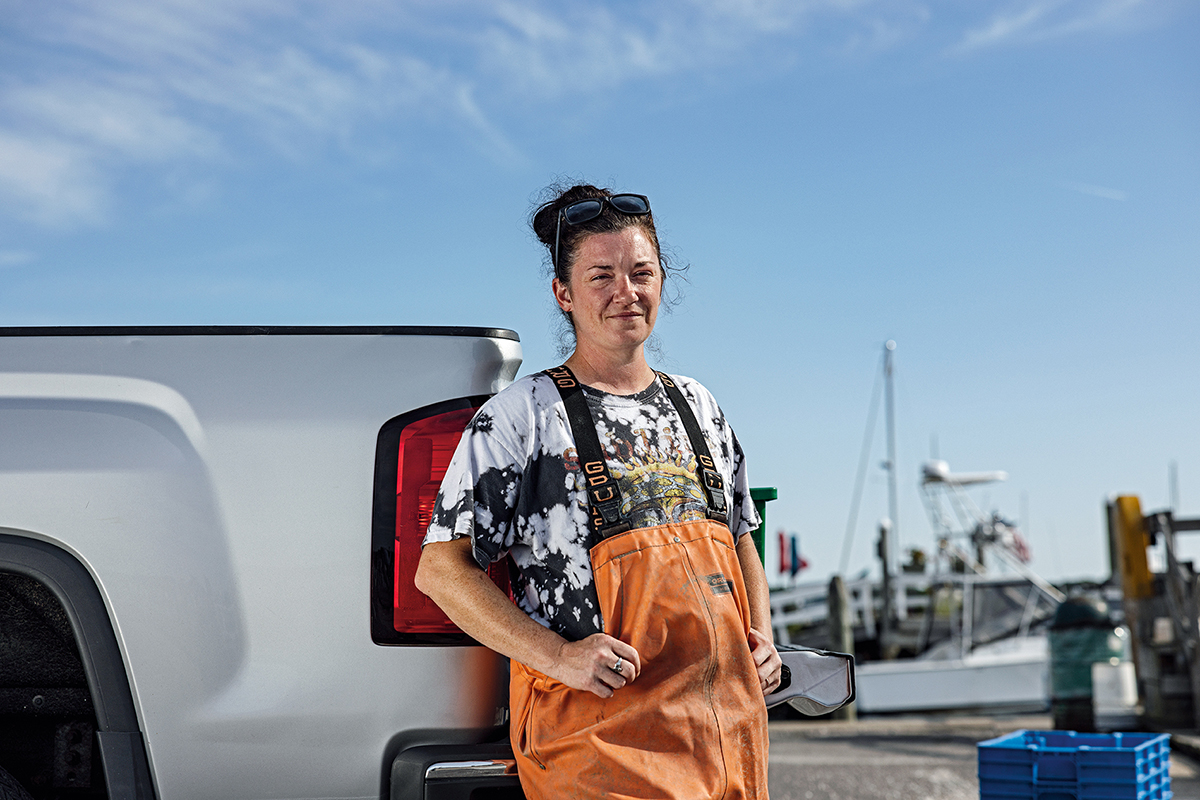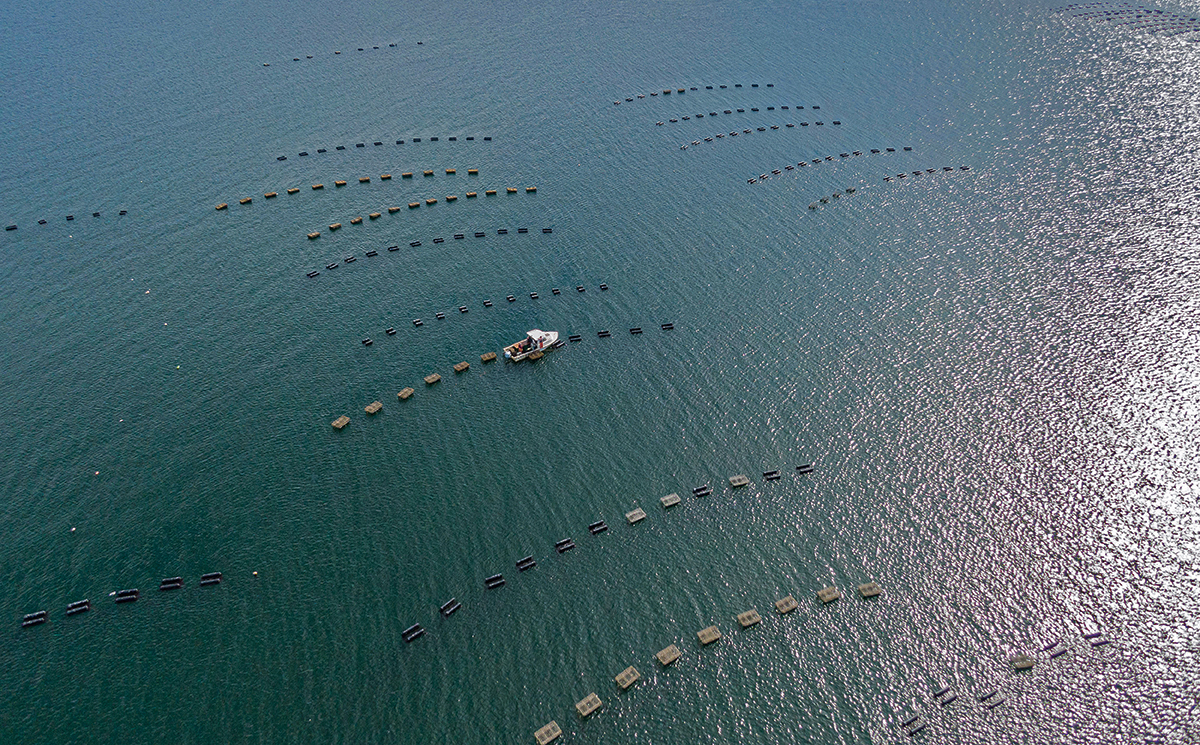Dirty, Muddy, Cold, and Wet––And Loving It
Oyster Farmers Describe Their Calling
By Pearl MarvellIT IS A SUNNY MORNING IN OCTOBER. The water is calm and sparkling in Wickford Cove. The fleet of pleasure yachts that normally crowd the bay during the summer have either made their way south or are hauled out for the season.
I meet Natalie O’Connor and Thomas Blank at the town dock. She has just dropped her kids off at the bus stop, and he’s getting his boat and gear ready to go out. Moments later, Russell Blank, Thomas’s uncle, shows up in his truck. The Blanks own Rome Point Oysters, while Thomas also owns Golden Nugget Oysters, which he will be harvesting for on this particular day since he has received an order for smaller oysters—Golden Nugget Oysters’ specialty.
Russell has been in the business for over 20 years. Before that he was a quahogger but became tired of “looking for the product.” He says he loves growing oysters because “my office changes every day,” and the work keeps him in shape.
Six years ago, O’Connor was cleaning houses and doing other odd jobs when her husband showed her a Ted Talk on aquaculture that she thought was “really awesome.”
Around the same time, she received an email with an opportunity to study aquaculture from the Education Exchange, a nonprofit that provides training and career advancement.
O’Connor completed the five-week program, which included three weeks of in-class learning and two weeks as an “in-the-field” intern, an opportunity that not only gives students hands-on experience but also allows potential employers the opportunity to see who is the best fit for their farm.
Though she originally thought she would be working in a hatchery, O’Connor was immediately hired by an oyster farm, and she soon fell in love with being out on the water. But it’s not just the scenery that makes the work enjoyable for her. It’s the satisfaction of seeing something grow, which in turn feeds others.
AT THE END OF THE DAY, YOU JUST PUT FOOD ON A PLATE

“At the end of the day, you just put food on a plate,” she says.
For the last year, she has been working for Russell Blank, and she appreciates that he makes sure she is back on land in time to pick up her kids from school, something that isn’t a given working for other oyster farmers.
We move out on the bay on one of the boats and head to protected water just outside of the harbor where there are half-circle rows of cages filled with oysters. Blank and O’Connor tie up to one of the rows and start to haul the cages on board the boat. Inside, there are sacks filled with oysters. Hundreds of them. The two get to work sorting the oysters, throwing back the ones that have been damaged by oyster drill snails or that are too small for harvest.
They work nearly in unison, bantering back and forth. After each cage is sorted through, Blank moves the boat up to the next cage and starts the process again, hauling the cages up with the help of a mechanized winch.
“It’s good for my brain,” says O’Connor about being out on the water. She knows that she won’t be able to do this work forever.
After all, it is a very physical job, but she plans to continue working in the industry for as long as she can. She envisions herself in an advocacy role later in her career, promoting aquaculture and “how great this is for our state,” as well as talking to potential oyster farmers and employees about the importance of farming oysters, not just as a food source, but also for keeping waterways clean.
“It’s a really special animal,” she says.
YOU CAN TELL WHICH ONES ARE GOING TO WORK OUT IN A COUPLE OF DAYS.
“It’s definitely not easy,” says Thomas Blank.
He says that when they’re chipping ice off the boat in the middle of winter, a lot of people have second thoughts about doing this for a living. Luckily, the Blanks seem to have an eye for those that will stay.
“You can tell which ones are going to work out or not in a couple of days,” he says.
Blank started this work when he was in high school and it seemed natural to him to continue once he graduated. He is well aware though, that for many people, this type of work doesn’t come easily.
Some farmers do take on college kids in the summer to help with the extra workload. In fact, Blank himself took on Sam Brower, a freshman in college, for the summer. She had originally babysat for Blank and his wife, but “wanted to be outside for the summer and do something physical,” after a year of staying indoors due to COVID. Plus, the pay—$20 an hour for five hours of work, five days a week—wasn’t bad.
Brower says it’s more than she would have made at a lot of other summer jobs. Although some of her friends thought it was strange work to be doing, Brower says she would definitely consider returning during future college breaks. However, Brower might be more the exception than the rule since the work requires working early in the morning and in all types of weather conditions.
Jennifer Scappatura, for example, who owns Quonnie Siren Oyster Co. on Quonochontaug Pond in Charlestown, says that because of the difficulty of the work and the amount of training involved, many college kids are not cut out for oyster farming. Her ideal employees “are the ones that believe in the industry. Those are the people that last.” That’s why she hired Jason Jarvis to be the manager of Quonnie Siren Oyster Co.
Jarvis is a commercial fisherman by trade, although he had previous aquaculture experience working at Watch Hill Oysters. In the spring of 2021, he was waiting on an outboard motor to come in for one of his boats.
As with so many things during the pandemic, there was a considerable wait on the outboard, so Jarvis’ boat was out of commission for a while. That was when Scappatura offered him the management position. He initially started part time but came on full time because Scappatura couldn’t find additional help.
“And that was that. I haven’t stopped,” he says.
Jarvis describes the work as “kind of his dream job.” “The amazing part of it is watching these things grow and turn into food,” he says.
“You get bitten by it, so to speak, and you don’t want to do anything else.” In fact, he jokes, “I plan on retiring when I’m 96.”

And Rhode Island oysters aren’t just eaten locally either. According to Russell and Thomas Blank, their oysters ship as far away as Chicago. Bob “Skid” Rheault, one of the state’s leading specialists in aquaculture as well as the lead instructor for the Education Exchange training program, says there has been a doubling in oyster production in the past 5 to 10 years.
While most of the farms are small and, on average, have fewer than five employees, he says there’s strong demand for well-trained employees, and every state that has an aquaculture industry is looking for workers.
“The reason we started this program is that we had this incredibly high turnover rate,” he says. “If you really don’t love this job, you are quickly going to grow to hate it because it is dirty and muddy and cold and wet.”
That is why he makes sure that students going through the program know what they are getting into. During one of the sessions, he will make the students carry a 5-gallon bucket of water up and down stairs, just to make sure that they are up to the job.
This year’s training for 12 participants includes an online program and a four-week in-person program, including the internships. Executive Director of the Education Exchange Jason Colonies says the program does not just focus on preparing individuals for work on a farm or in a hatchery, it also provides them with the skills often needed in the restaurant industry when it comes to safely handling and serving oysters.
Many of the students that graduate end up working for catering companies or in restaurants.
The program also offers students the opportunity to train and test for their captain’s license, another asset to oyster farmers who often offer eco-tours of their farms.
“We’re all about taking down barriers for people now and getting people back to work and getting people into good places,” he says.
Both Colonies and Rheault are committed to ensuring that the aquaculture program attracts people from a variety of backgrounds and communities, and they are working to get the word out in more diverse cities and towns throughout the state.
Colonies says that there is an effort to recruit more from the northern Rhode Island area as well as in Newport and Middletown.
All the programs run by Education Exchange and Real Jobs Rhode Island also provide incentives to their students. When O’Connor did the program, for instance, she was paid minimum wage for the duration.
According to the Coastal Resources Management Council, full-time and seasonal aquaculture farm jobs have steadily risen over the past decade, with only a slight dip in 2020. Both Colonies and Rheault expect those numbers to continue to increase.
After O’Connor and Russell Blank have harvested all the oysters they need to fill their quota for a delivery, we head back into the dock, but not without an visit from a few friends along the way.
A seagull lands on the boat, and Blank feeds her peanuts. He affectionately calls her “Black Eyes” because of the black circles around her beady, unblinking eyes. She visits the boat nearly every day and has done so for many years.
A loon comes over to the boat to see what snacks are available. O’Connor calls the loon “Puppy” because it acts just like a dog wanting a treat. It feels good being on the water, O’Connor says.
“It’s beautiful out here. It kind of gets in your soul.”
Once the boat returns to dock and she and Blank finish up their work, she will have just enough time to get to the bus stop to pick up her four kids and head home for the day—and do it all again tomorrow.
Contact Us
Telephone: (401) 874-6805
Email: allard@uri.edu
Contributor Guidelines
Please review submission guidelines to be considered. d


